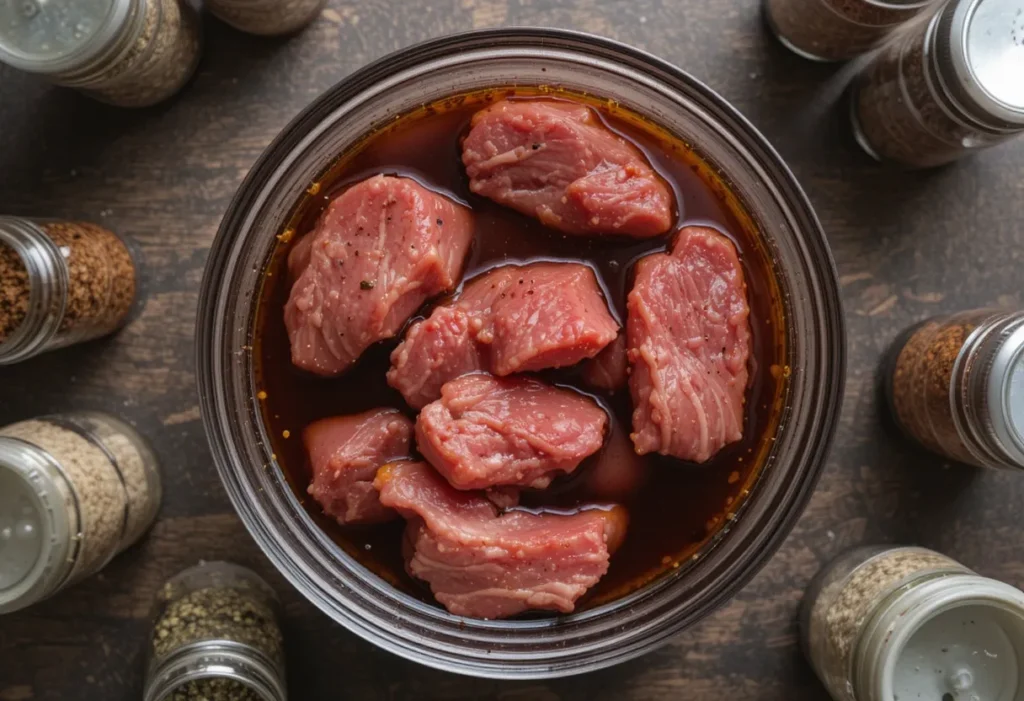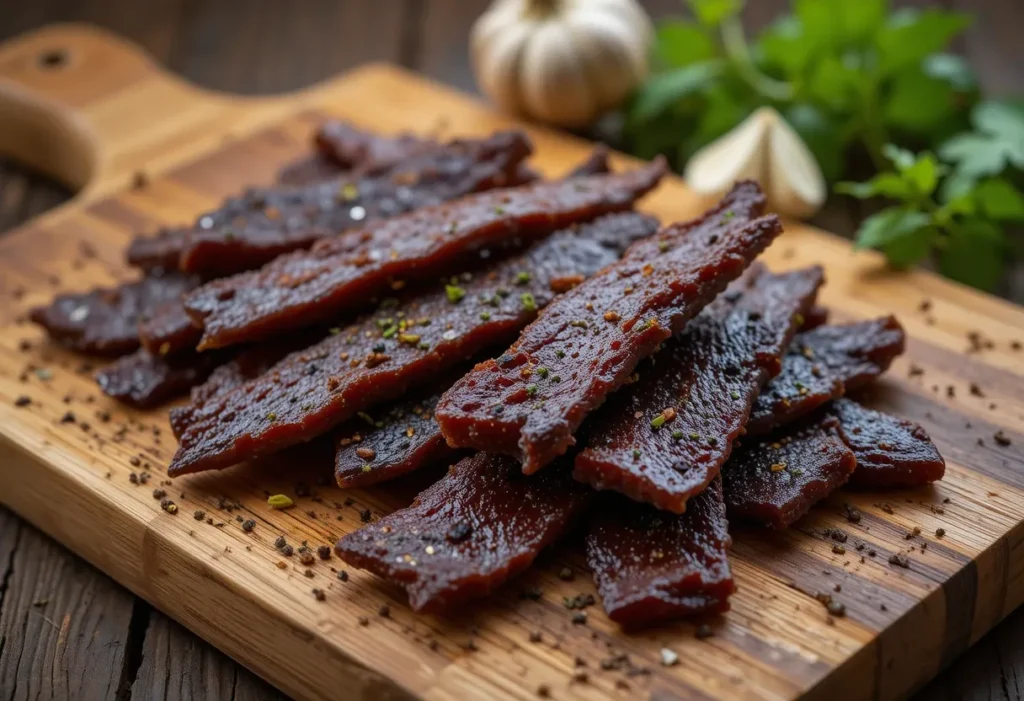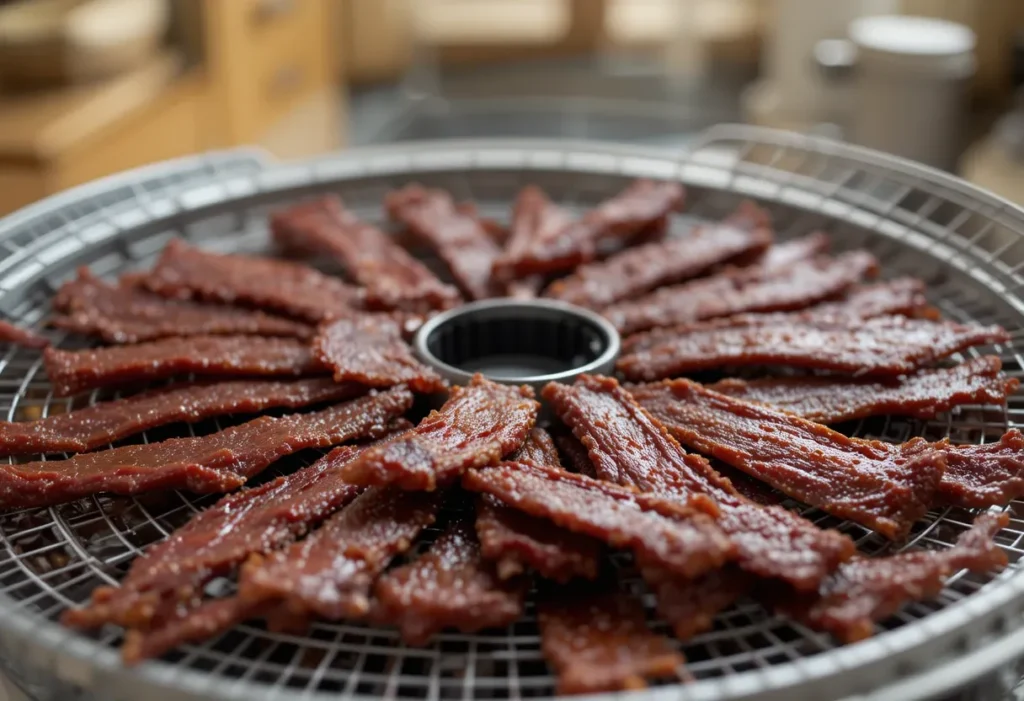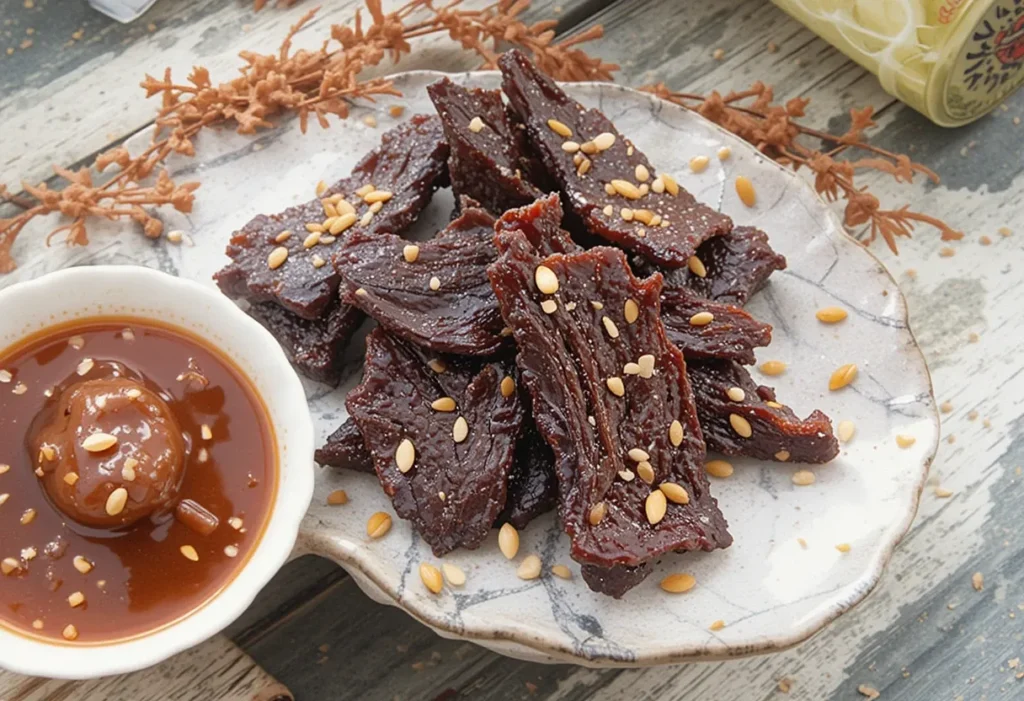Table of Contents
Introduction
Ever bite into a piece of jerky and think, “Whoa, how do they make this stuff so good?” Well, guess what—you don’t need to wonder anymore. Making beef jerky at home is easier than you think, and it’s not just a fun kitchen experiment—it’s a way to snack smarter, save money, and add a punch of flavor to your life. 💥
In this ultimate guide, we’re going to break down everything you need to know about making homemade beef jerky—from the best cuts of meat to mouthwatering marinade recipes, common mistakes to avoid, and even how to store your jerky so it lasts (but let’s be real—it’ll probably be gone in a few days anyway 😄).
Whether you’re a jerky junkie or a total beginner, this guide has got your back. Let’s get into it!
“Good jerky is like good music—it’s all about the right mix of ingredients and timing.” 🎶

What Is Beef Jerky?
Beef jerky is lean meat that’s been trimmed, sliced, marinated, and dried to remove moisture. This process preserves the meat while packing it with flavor and texture. The result? A chewy, protein-packed snack that’s been a go-to for centuries.
A Brief History of Jerky
The word jerky comes from the Quechua word “ch’arki”, which means dried, salted meat. Indigenous people in South America and North America were making jerky long before it hit grocery store shelves. It was a reliable, portable protein source that didn’t spoil—perfect for warriors, hunters, and travelers.
Fast-forward to today, and beef jerky is everywhere—from convenience stores to gourmet shops. But the best jerky? Still the kind you make yourself.
Why People Love Making It at Home
Store-bought jerky can be convenient, but it’s often loaded with preservatives, sugar, and… well, mystery ingredients. 🤔
Homemade jerky gives you total control—over flavor, texture, spice level, and quality. Plus, it’s kind of addictive to make (in a good way).
Key Benefits of Homemade Beef Jerky
Let’s be real—homemade jerky isn’t just fun to make; it comes with some real perks. Check it out:
Cost Savings
Ever notice how expensive jerky is in the store? You’re paying for packaging, branding, and convenience. Making it at home can cut your jerky budget in half—or more!
Control Over Ingredients
Want low-sodium? Done. No sugar? Easy. Extra spicy? Bring it on. You get to pick exactly what goes into your jerky and what stays out.
Custom Flavor Options
Sweet, smoky, spicy, or all three—your flavor game is only limited by your imagination. You can experiment with marinades and spices to create a jerky masterpiece.
Best Cuts of Beef for Jerky
Not all beef is created equal—especially when it comes to jerky. The right cut can mean the difference between chewy deliciousness and a stringy mess. 😬
Top 5 Recommended Beef Cuts
Here are the MVPs (Most Valuable Proteins) for jerky-making:
| Beef Cut | Why It Works |
|---|---|
| Top Round | Lean, affordable, and easy to slice thin. |
| Bottom Round | Slightly more marbling, still lean and jerky-ready. |
| Eye of Round | Very lean, uniform shape, great texture. |
| Sirloin Tip | Tender and lean, slightly more expensive. |
| Flank Steak | Flavorful and thin, but can be tougher to chew. |
Pro Tip: “Go for lean meat with minimal fat—fat doesn’t dehydrate well and can go rancid.”
Trimming and Slicing Tips
Before marinating, trim all visible fat off your meat. Then slice it thin—about 1/8″ to 1/4″ thick. Want chewier jerky? Slice with the grain. Prefer a softer bite? Go against the grain.
You can partially freeze your meat for 30-60 minutes to make slicing easier. Trust us, your fingers will thank you. 🧊🔪

Tools You’ll Need to Make Beef Jerky
No fancy gadgets required (unless you’re into that). You can make amazing jerky with just a few basic tools.
Dehydrator vs Oven: Pros & Cons
| Tool | Pros | Cons |
|---|---|---|
| Dehydrator | Even drying, energy efficient, hands-off. | Another appliance to store. |
| Oven | Already in your kitchen, works fine for beginners. | Requires supervision and racks. |
If you’re serious about jerky, a dehydrator is a great investment. But if you’re just trying it out, your oven will do just fine.
Knives, Storage, and Prep Tools
- Sharp Knife – for slicing meat thinly and evenly.
- Cutting Board – preferably one just for meat.
- Ziplock Bags or Containers – for marinating.
- Cooling Racks – for oven-drying.
- Airtight Jars or Vacuum Bags – to store your finished jerky.
Having the right tools makes the process smoother and safer.
💡 Nutrition Facts Table: Homemade Beef Jerky (Per 1 oz Serving)
| Nutrient | Amount |
|---|---|
| Calories | 116 kcal |
| Protein | 9.4 g |
| Fat | 7.3 g |
| Carbs | 3.1 g |
| Sodium | 590 mg |
| Sugar | 2.6 g |
These values can vary depending on your marinade ingredients and meat cut.

How to Make Beef Jerky: Step-by-Step Guide
Okay, you’ve got your meat, tools, and you’re hyped—now what? Here’s how to make beef jerky the right way, step by step. 👇
Step 1: Choosing the Right Meat
Stick to lean, high-protein cuts with little to no fat. The leaner the cut, the longer your jerky will last—and the better it’ll taste. Refer back to our Top 5 Cuts chart in Part 1 for your best options!
Step 2: Preparing the Marinade
This is where the magic happens. Your marinade adds flavor, helps tenderize the meat, and can even assist in preservation if you add curing salt (optional but helpful).
📝 Basic Marinade Formula:
- Acid (like vinegar or citrus juice)
- Salty element (soy sauce, Worcestershire)
- Sweet (brown sugar or honey)
- Spice (pepper, chili flakes)
- Garlic/onion for kick
Let your creativity shine here!
Step 3: Marinating the Meat
Put your sliced beef into a ziplock bag or covered dish with the marinade. Let it soak in the fridge for 12 to 24 hours. The longer, the deeper the flavor. Flip it occasionally to make sure every piece gets the love.
“Patience isn’t just a virtue—it’s the secret ingredient to amazing jerky.” 🙌
Step 4: Drying the Jerky
- Dehydrator Method: Set your dehydrator to 160°F (71°C). Lay strips flat with space between. Dry for 4–6 hours.
- Oven Method: Preheat to 170°F (or lowest temp). Place jerky on racks over baking sheets and prop the oven door slightly open with a wooden spoon. Dry for 4–6 hours.
You’ll know it’s done when the jerky bends but doesn’t snap.
Step 5: Cooling and Storing
Let jerky cool completely on a wire rack. Once cooled, store in an airtight container or vacuum-seal it. Keep it in a cool, dry place—or pop it in the fridge for longer shelf life.
Top 3 Beef Jerky Marinade Recipes
Here are three tried-and-true flavor combos to get you started. 🧄🌶️🍯
Classic Savory Style
Ingredients:
- ½ cup soy sauce
- ¼ cup Worcestershire sauce
- 1 tsp black pepper
- 1 tsp onion powder
- 1 tsp garlic powder
- 1 tbsp brown sugar
Rich, balanced, and bold—this one’s a go-to for good reason.
Sweet & Spicy Teriyaki
Ingredients:
- ½ cup teriyaki sauce
- 2 tbsp honey
- 1 tsp chili flakes
- 1 tsp fresh grated ginger
- ½ tsp sesame oil
A perfect yin-yang of sweet and heat. 🔥🍯
Smoky BBQ Flavor
Ingredients:
- ½ cup BBQ sauce
- 1 tbsp apple cider vinegar
- 1 tsp smoked paprika
- 1 tsp cayenne (optional)
- Dash of liquid smoke
This one brings the BBQ to your snack game. 🍖

Common Mistakes and How to Avoid Them
Over-drying or Underdrying
👉 Problem: Jerky that’s too brittle or too soft.
Fix: Always check by bending. It should bend and crack slightly but not snap.
Using Fatty Meat
👉 Problem: Fat doesn’t dry well and spoils fast.
Fix: Trim all visible fat before slicing.
Skipping the Cure or Marinade Time
👉 Problem: Weak flavor or unsafe food.
Fix: Marinate for at least 12 hours, and consider adding a curing agent if you’re storing jerky long-term.
How to Store Beef Jerky Properly
Fridge, Freezer, or Pantry?
| Storage Method | Shelf Life |
|---|---|
| Pantry (sealed bag) | 1–2 weeks |
| Fridge (airtight) | 2–3 months |
| Freezer (vacuum sealed) | 6 months or more |
For max freshness, vacuum sealing is 💯.
Shelf Life and Spoilage Signs
Signs your jerky’s gone bad:
- Sour smell
- Slimy texture
- Mold spots
When in doubt, throw it out.
Nutritional Breakdown of Beef Jerky
Let’s talk macros. Beef jerky is a high-protein, low-carb snack, but it can be high in sodium depending on your recipe.
Is It Healthy? Pros and Cons
✅ Pros:
- High in protein
- Low in sugar (if you keep it that way)
- Portable & non-perishable
❌ Cons:
- Can be high in sodium
- Watch out for sugar-laden store-bought options
Beef Jerky for Special Diets
Keto & Low-Carb Options
Skip the sugar and use coconut aminos instead of soy sauce. Add chili flakes or smoked salt for flavor without carbs.
Gluten-Free & Low-Sodium Adjustments
- Use gluten-free tamari
- Cut back on soy sauce or use low-sodium versions
- Skip the curing salt if sodium is a concern
Creative Ways to Use Beef Jerky
Jerky isn’t just for snacking!
Snacking, Cooking, and Gifting Ideas
- Crumble it over salads 🥗
- Toss into trail mix
- Use as a pizza topping (seriously)
- Add to soups for a protein kick
Camping & Emergency Food Uses
Jerky is a lifesaver on hiking trips, long drives, or emergency kits. It’s light, filling, and shelf-stable.
“Jerky is the Swiss Army knife of snacks—versatile, reliable, and ready when you are.” 🏕️
FAQs About Beef Jerky Recipe
How long should I marinate the meat?
12 to 24 hours is ideal. Overnight works best for full flavor.
Can I make jerky without a dehydrator?
Absolutely. Use your oven on low heat and crack the door open to let moisture escape.
Do I have to use curing salt?
Not necessarily. If you store jerky in the fridge and consume it within a week or two, you’re fine without it.
Can I use ground beef?
Yes, but you’ll need a jerky gun or press. It’s a whole different texture and drying method.
How do I know when jerky is done?
It should bend and crack slightly but not break. It should feel dry but still flexible.
How long does homemade jerky last?
Stored properly, 1–2 weeks at room temp, 2–3 months in the fridge, and 6 months in the freezer.
Conclusion
Making your own beef jerky isn’t just satisfying—it’s downright fun. You control the flavor, the quality, and the process. Whether you’re going classic or bold with flavor, you’ll never look at store-bought jerky the same way again.
So roll up your sleeves, fire up that oven or dehydrator, and let the jerky adventures begin! 🥩✨

